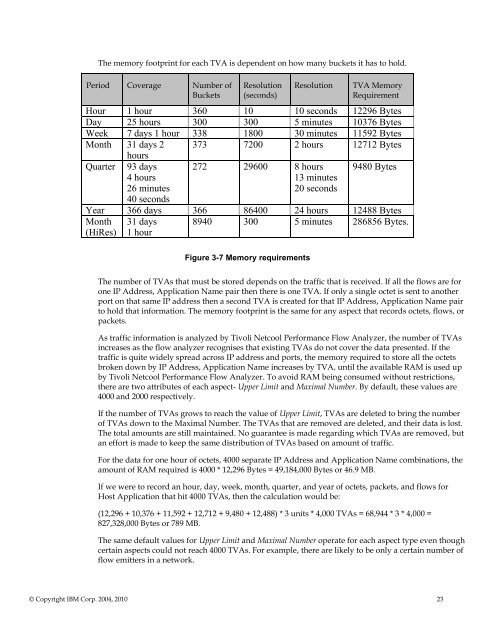TNPFA 4.1.1 Installation and User Guide - e IBM Tivoli Composite ...
TNPFA 4.1.1 Installation and User Guide - e IBM Tivoli Composite ...
TNPFA 4.1.1 Installation and User Guide - e IBM Tivoli Composite ...
Create successful ePaper yourself
Turn your PDF publications into a flip-book with our unique Google optimized e-Paper software.
The memory footprint for each TVA is dependent on how many buckets it has to hold.<br />
Period Coverage Number of<br />
Buckets<br />
Resolution<br />
(seconds)<br />
Resolution TVA Memory<br />
Requirement<br />
Hour 1 hour 360 10 10 seconds 12296 Bytes<br />
Day 25 hours 300 300 5 minutes 10376 Bytes<br />
Week 7 days 1 hour 338 1800 30 minutes 11592 Bytes<br />
Month 31 days 2 373 7200 2 hours 12712 Bytes<br />
hours<br />
Quarter 93 days<br />
4 hours<br />
26 minutes<br />
40 seconds<br />
272 29600 8 hours<br />
13 minutes<br />
20 seconds<br />
9480 Bytes<br />
Year 366 days 366 86400 24 hours 12488 Bytes<br />
Month 31 days 8940 300 5 minutes 286856 Bytes.<br />
(HiRes) 1 hour<br />
Figure 3-7 Memory requirements<br />
The number of TVAs that must be stored depends on the traffic that is received. If all the flows are for<br />
one IP Address, Application Name pair then there is one TVA. If only a single octet is sent to another<br />
port on that same IP address then a second TVA is created for that IP Address, Application Name pair<br />
to hold that information. The memory footprint is the same for any aspect that records octets, flows, or<br />
packets.<br />
As traffic information is analyzed by <strong>Tivoli</strong> Netcool Performance Flow Analyzer, the number of TVAs<br />
increases as the flow analyzer recognises that existing TVAs do not cover the data presented. If the<br />
traffic is quite widely spread across IP address <strong>and</strong> ports, the memory required to store all the octets<br />
broken down by IP Address, Application Name increases by TVA, until the available RAM is used up<br />
by <strong>Tivoli</strong> Netcool Performance Flow Analyzer. To avoid RAM being consumed without restrictions,<br />
there are two attributes of each aspect- Upper Limit <strong>and</strong> Maximal Number. By default, these values are<br />
4000 <strong>and</strong> 2000 respectively.<br />
If the number of TVAs grows to reach the value of Upper Limit, TVAs are deleted to bring the number<br />
of TVAs down to the Maximal Number. The TVAs that are removed are deleted, <strong>and</strong> their data is lost.<br />
The total amounts are still maintained. No guarantee is made regarding which TVAs are removed, but<br />
an effort is made to keep the same distribution of TVAs based on amount of traffic.<br />
For the data for one hour of octets, 4000 separate IP Address <strong>and</strong> Application Name combinations, the<br />
amount of RAM required is 4000 * 12,296 Bytes = 49,184,000 Bytes or 46.9 MB.<br />
If we were to record an hour, day, week, month, quarter, <strong>and</strong> year of octets, packets, <strong>and</strong> flows for<br />
Host Application that hit 4000 TVAs, then the calculation would be:<br />
(12,296 + 10,376 + 11,592 + 12,712 + 9,480 + 12,488) * 3 units * 4,000 TVAs = 68,944 * 3 * 4,000 =<br />
827,328,000 Bytes or 789 MB.<br />
The same default values for Upper Limit <strong>and</strong> Maximal Number operate for each aspect type even though<br />
certain aspects could not reach 4000 TVAs. For example, there are likely to be only a certain number of<br />
flow emitters in a network.<br />
© Copyright <strong>IBM</strong> Corp. 2004, 2010 23

















